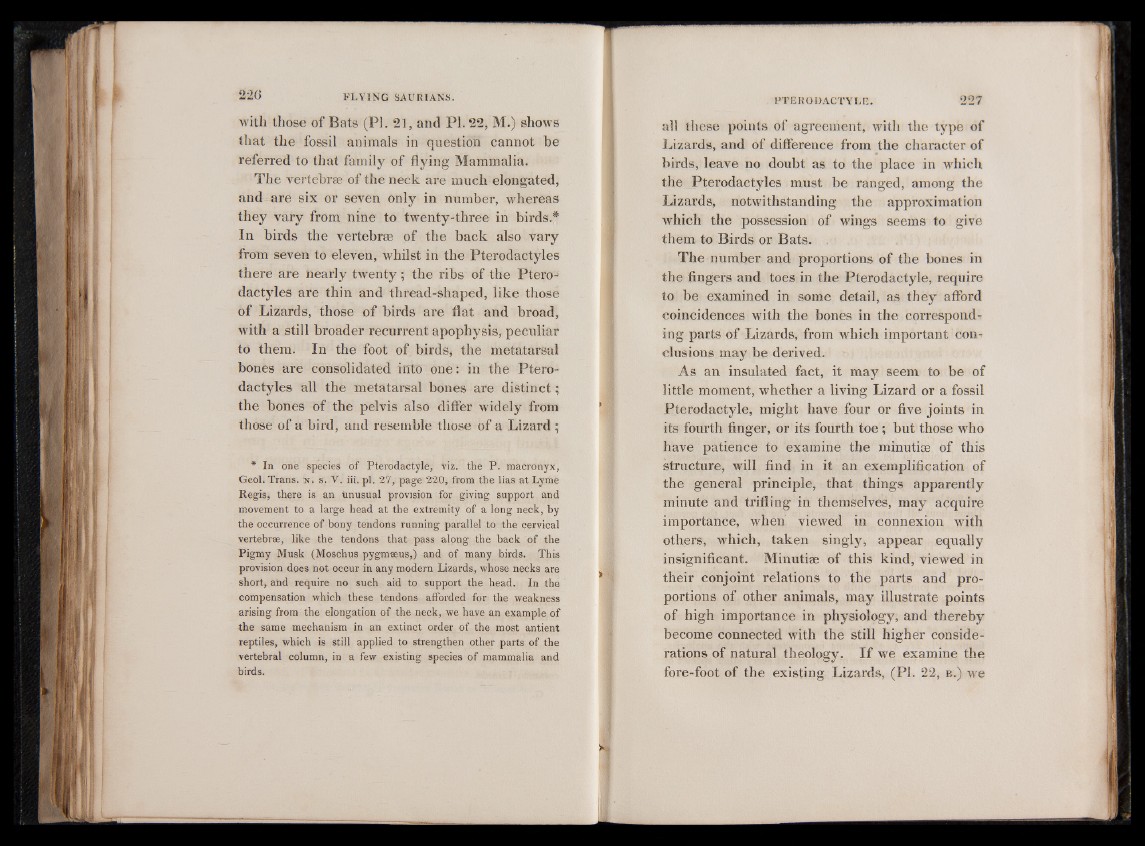
with those of Bats (PI. 21, and PI. 22, M.) shows
that the fossil animals in question cannot be
referred to that family of flying Mammalia.
The vertebrae of the neck are much elongated,
and are six or seven only in number, whereas
they vary from nine to twenty-three in birds.*
In birds the vertebrae of the back also vary
from seven to eleven, whilst in the Ptérodactyles
there are nearly twenty ; the ribs of the Pteroj
dactyles are thin and thread-shaped, like those
of Lizards, those of birds are flat and broad,
with a still broader recurrent apophysis, peculiar
to them. In the foot of birds, the metatarsal
bones are consolidated into one : in the Ptérodactyles
all the metatarsal bones are distinct ;
the bones of the pelvis also differ widely from
those of a bird, and resemble those of a Lizard ;
* In one species of Ptérodactyle, viz. the P. macronyx,
Geol. Trans, n . s . V. iii. pi. 27, page 220, from the lias at Lyme
Regis, there is an unusual provision for giving support and
movement to a large head at the extremity of a long neck, by
the occurrence of bony tendons running parallel to the cervical
vertebrae, like the tendons that pass along the back of the
Pigmy Musk (Moschus pygmaeus,) and of many birds. This
provision does not occur in any modern Lizards, whose necks are
short, and require no such aid to support the head. In the
compensation which these tendons afforded for the weakness
arising from the elongation of the neck, we have an example of
the same mechanism in an extinct order of the most antient
reptiles, which is still applied to strengthen other parts of the
vertebral column, in a few existing species of mammalia and
birds.
all these points of agreement, with the type of
Lizards, and of difference from the character of
birds, leave no doubt as to the place in which
the Pterodactyles must be ranged, among the
Lizards, notwithstanding the approximation
which the possession of wings seems to give
them to Birds or Bats. .
The number and proportions of the bones in
the fingers and toes in the Pterodactyle, require
to be examined in some detail, as they afford
coincidences with the bones in the corresponding
parts of Lizards, from which important com
elusions may be derived.
As an insulated fact, it may seem to be of
little moment, whether a living Lizard or a fossil
Pterodactyle, might have four or five joints in
its fourth finger, or its fourth toe ; but those who
have patience to examine the minutiae of this
structure, will find in it an exemplification of
the general principle, that things apparently
minute and trifling in themselves, may acquire
importance, when viewed in connexion with
others, which, taken singly, appear equally
insignificant. Minutiae of this kind, viewed in
their conjoint relations to the parts and proportions
of other animals, may illustrate points
of high importance in physiology, and thereby
become connected with the still higher considerations
of natural theology, I f we examine the
fore-foot of the existing Lizards, (PI. 22, b.) we